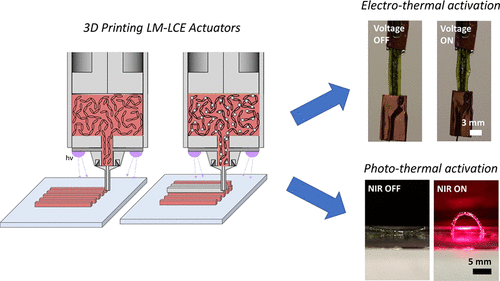当前位置:
X-MOL 学术
›
ACS Appl. Mater. Interfaces
›
论文详情
Our official English website, www.x-mol.net, welcomes your
feedback! (Note: you will need to create a separate account there.)
4D-Printable Liquid Metal–Liquid Crystal Elastomer Composites
ACS Applied Materials & Interfaces ( IF 8.3 ) Pub Date : 2020-12-24 , DOI: 10.1021/acsami.0c19051 Cedric P. Ambulo 1 , Michael J. Ford 2 , Kyle Searles 1 , Carmel Majidi 2 , Taylor H. Ware 1, 3, 4
ACS Applied Materials & Interfaces ( IF 8.3 ) Pub Date : 2020-12-24 , DOI: 10.1021/acsami.0c19051 Cedric P. Ambulo 1 , Michael J. Ford 2 , Kyle Searles 1 , Carmel Majidi 2 , Taylor H. Ware 1, 3, 4
Affiliation

|
Soft actuators that undergo programmable shape change in response to a stimulus are enabling components of future soft robots and other soft machines. Strategies to power these actuators often require the incorporation of rigid, electrically conductive materials into the soft actuator, thus limiting the compliance and shape change of the material. In this study, we develop a 4D-printable composite composed of liquid crystal elastomer (LCE) matrix with dispersed droplets of eutectic gallium indium alloy (EGaIn). Using deformable EGaIn droplets in place of rigid conductive fillers preserves the compliance and shape-morphing properties of the LCE. The process enables 4D-printed LCE actuators capable of photothermal and electrothermal actuation. At low liquid metal (LM) concentrations (71 wt %), the composite actuator exhibits a photothermal response upon irradiation of near-IR light. Printed actuators with a twisted nematic configuration are capable of bending angles of 150° at 800 mW cm–2. At higher LM concentrations (88 wt %), the embedded LM droplets can form percolating networks that conduct electricity and enable electrical Joule heating of the LCE. Actuation strain ranging from 5 to 12% is controlled by the amount of electrical power that is delivered to the composite. We also introduce a method for multimaterial printing of monolithic structures where the LM filler loading is spatially varied. These multifunctional materials exhibit innate responsivity where the actuator behaves as an electrical switch and can report one of two states (on/off). These multiresponsive, 4D-printable composites enable multifunctional, mechanically active structures that can be powered with IR light or low DC voltages.
中文翻译:

4D可打印液态金属-液晶弹性体复合材料
响应于刺激而经历可编程形状变化的软促动器使将来的软机器人和其他软机器的组件成为可能。为这些执行器提供动力的策略通常需要将刚性的导电材料结合到软执行器中,从而限制了材料的柔韧性和形状变化。在这项研究中,我们开发了一种由液晶弹性体(LCE)基质与共晶镓铟合金(EGaIn)分散液滴组成的4D可打印复合材料。使用可变形的EGaIn小滴代替硬质导电填料可保持LCE的柔韧性和形状变形特性。该过程使能够进行光热和电热致动的4D打印LCE致动器成为可能。在液态金属(LM)浓度低(71 wt%)的情况下,复合致动器在照射近红外光时表现出光热响应。带向列扭曲结构的印刷执行器在800 mW cm时能够弯曲150°–2。在较高的LM浓度(88 wt%)下,嵌入的LM液滴会形成渗流网络,该渗流网络导电并实现LCE的电焦耳加热。致动应变在5%到12%的范围内,是由传递到复合材料的电功率控制的。我们还介绍了一种用于LM填料填充量在空间上变化的整体结构的多材料印刷方法。这些多功能材料表现出与生俱来的响应度,其中执行器充当电子开关,并且可以报告两种状态(打开/关闭)之一。这些可多点响应,可4D打印的复合材料实现了多功能的机械主动结构,可以通过红外光或低直流电压为其供电。
更新日期:2020-12-24
中文翻译:

4D可打印液态金属-液晶弹性体复合材料
响应于刺激而经历可编程形状变化的软促动器使将来的软机器人和其他软机器的组件成为可能。为这些执行器提供动力的策略通常需要将刚性的导电材料结合到软执行器中,从而限制了材料的柔韧性和形状变化。在这项研究中,我们开发了一种由液晶弹性体(LCE)基质与共晶镓铟合金(EGaIn)分散液滴组成的4D可打印复合材料。使用可变形的EGaIn小滴代替硬质导电填料可保持LCE的柔韧性和形状变形特性。该过程使能够进行光热和电热致动的4D打印LCE致动器成为可能。在液态金属(LM)浓度低(71 wt%)的情况下,复合致动器在照射近红外光时表现出光热响应。带向列扭曲结构的印刷执行器在800 mW cm时能够弯曲150°–2。在较高的LM浓度(88 wt%)下,嵌入的LM液滴会形成渗流网络,该渗流网络导电并实现LCE的电焦耳加热。致动应变在5%到12%的范围内,是由传递到复合材料的电功率控制的。我们还介绍了一种用于LM填料填充量在空间上变化的整体结构的多材料印刷方法。这些多功能材料表现出与生俱来的响应度,其中执行器充当电子开关,并且可以报告两种状态(打开/关闭)之一。这些可多点响应,可4D打印的复合材料实现了多功能的机械主动结构,可以通过红外光或低直流电压为其供电。


















































 京公网安备 11010802027423号
京公网安备 11010802027423号